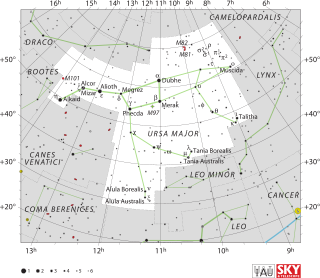Beta Ursae Majoris
| Observation data Epoch J2000.0 Equinox J2000.0 |
|
|---|---|
| Constellation | Ursa Major |
| Right ascension | 11h 01m 50.47654s |
| Declination | +56° 22′ 56.7339″ |
| Apparent magnitude (V) | +2.37 |
| Characteristics | |
| Spectral type | A1IVps |
| U−B color index | +0.00 |
| B−V color index | -0.02 |
| Variable type | Suspected |
| Astrometry | |
| Radial velocity (Rv) | -12.0 km/s |
| Proper motion (μ) |
RA: +81.43 mas/yr Dec.: +33.49 mas/yr |
| Parallax (π) | 40.90 ± 0.16mas |
| Distance | 79.7 ± 0.3 ly (24.45 ± 0.10 pc) |
| Details | |
| Mass | 2.7 M☉ |
| Radius | 3.021 ± 0.038 R☉ |
| Luminosity | 63.015 ± 1.307 L☉ |
| Surface gravity (log g) | 3.83 cgs |
| Temperature | 9377 ± 75 K |
| Rotational velocity (v sin i) | 46 km/s |
| Age | 500 ± 100 Myr |
| Other designations | |
| Database references | |
| SIMBAD | data |
Beta Ursae Majoris (β Ursae Majoris, abbreviated Beta UMa, β UMa), also named Merak, is a star in the northern circumpolar constellation of Ursa Major.
The apparent visual magnitude of this star is +2.37, which means it is readily visible to the naked eye. It is more familiar to northern hemisphere observers as one of the "pointer stars" in the Big Dipper or the Plough (UK), which is a prominent asterism of seven stars that forms part of the larger constellation. Extending an imaginary straight line from this star through the nearby Alpha Ursae Majoris (Dubhe) extends to Polaris, the north star.
Based upon parallax measurements of this star, it is located at a distance of 79.7 light-years (24.4 parsecs) from the Sun. The spectrum shows this to have a stellar classification of A1 V, making it a fairly typical main sequence star that is generating energy through the thermonuclear fusion of hydrogen at its core. The effective temperature of the outer envelope is about 9,225 K, giving it a white-hued glow that is typical for A-type stars. It is larger than the Sun, with about 2.7 times the mass and 2.84 times the Solar radius. If they were viewed from the same distance, Beta Ursae Majoris would appear much brighter than the Sun, as it is radiating 68 times the Sun's luminosity.
...
Wikipedia

